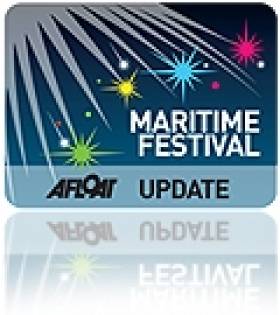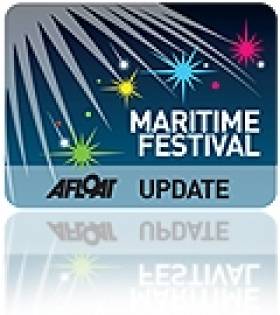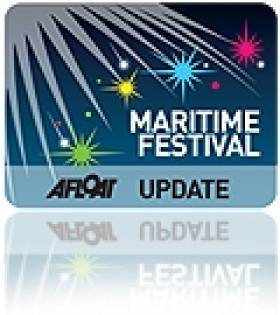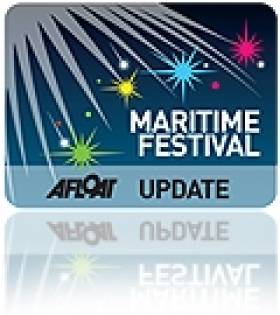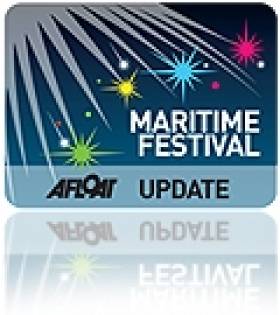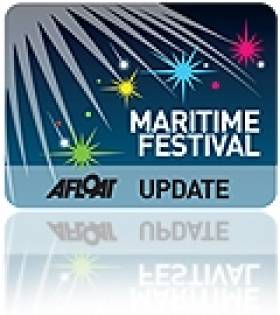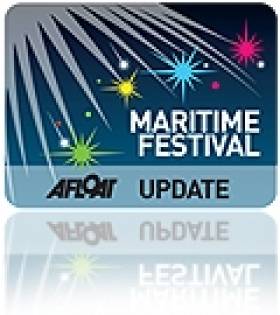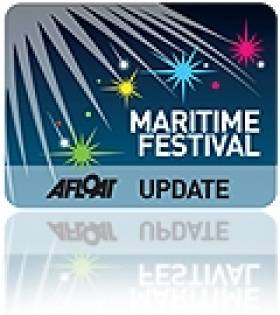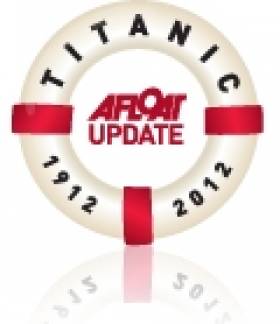Displaying items by tag: Maritime Festivals
#MaritimeFestival – The Docklands Summer Festival, which this year is sponsored by Waterways Ireland, is a celebration of the Grand Canal Dock next weekend (17-18 May) and where entertainment and competitions are held on the water and on dry land.
The festival continues to entertain, from open air DJ's, Come Try it Sessions, Wake Boarding demonstrations to international food markets, the festival organisers promise an entertaining and fun filled weekend for all.
On the water activities include a wakeboarding competition, charity rubber ducky race, water sports, 'Come and Try It' sessions in kayaking and a canal barge gathering.
Additionally, there is plenty of activity for families to enjoy such as open air DJ's, an outdoor market, corporate golf challenge, street performers, balloon artists, face painters, fun fair attractions, & children's arts centre and theatre performances in the Waterways Ireland Visitor Centre.
Come and see world-class wakeboarding demonstrations on Saturday or watch as world-class wakeboarders, from up to seven countries to take part in the first International Wakeboarding Championship at Grand Canal Dock.
The wakeboard extravaganza will be formed by members of the International Waterski & Wakeboard Federation (IWWF). Irish teams will give wakeboarding demonstrations in the Grand Canal Dock on Saturday.
On the following Sunday, International riders will compete with the world's best water skiing skills and tricks over ramps while being towed behind a high performance motorboat.
East Wall Water Sports Centre will be on hand during the festival each day from 11am until 5pm to take you on the water to try out kayaking! Festival rates of €10 per adult and €5 per child. For more details of festival programme visit this link.
Great Food, Great Fun At Howth's Dublin Bay Prawn Festival
#MaritimeFestivals - It's April, which means it's almost time for the annual Dublin Bay Prawn Festival - running this year from Friday 25 to Sunday 27 April.
Whatever way you like your prawns – barbecued, whole, shelled, fried, skewered, marinated or sauced – Howth’s many award-winning restaurants will serve your favourite prawn dishes in bite-sized portions at the Food Village adjacent to Howth Yacht Club.
But the food is just one part of a whole programme of events over the weekend that includes a mystery dine-around, historic walking tours of the North Dublin fishing village, and a 'Prawn Push' in aid of Howth RNLI.
And just like last year, Dublin Bay Cruises will be running special trips to Howth, this time from the city centre - so you can arrive at the festival by sea!
Full details of this year's Dublin Bay Prawn Festival are available on the official website HERE.
Achill Island Welcomes Kitesurfers For Irish Tour's Last Stop
#Kitesurfing - It will be last kite flying when Ireland's kitesurfers take to the water on Achill Island this weekend 28-29 September to battle some of the best in the world at the final stop on the Irish Kitesurfing Tour Competition.
As the Mayo Advertiser reports, the kitesurfing event will be celebrated on dry land, too, with the Battle for the Lake Music and Kite Festival, as spectators watch all the action on Keel Lake - considered one of the world's best spots for the sport - and enjoy live music, a funfair and BBQ on the lakeshore.
The Mayo Advertiser has more on the story HERE.
Wexford the Model 'Boat' County
#MaritimeFeatival - Irelands largest Model-Boat Exhibition will be held during the 2nd John Barry Maritime Festival in Wexford.
The Model Boat Exhibition takes place on the weekend of 22-23 June (11am-5pm) as part of the four-day festival which starts tomorrow and ends on Sunday.
Exhibiting an extensive range of model displays will be from the Rosslare Maritime Museum, the Boat Builders Project, the Marine Institute's Touch Tank, Irish Navy aswell as maritime stalls selling their wares.
As previously reported on Afloat.ie the John Barry and JFK Photographic Exhibition is to held in the Talbot Hotel as part of the festival's new Maritime & Heritage Cultural Walking Trail.
For details of the festival full programme visit: www.jbmf.ie/en/festival/festival-programme-2013
#MaritimeFestival – As previously reported on Afloat.ie the 2nd John Barry Maritime Festival (20-23 June) starts this week and is a celebration of the Wexford-born Commodore John Barry, father of the US Navy.
The four-day festival covers Wexford's rich maritime heritage and culture where all proceeds go towards the Wexford RNLI. Keeping to a nautical theme, a new Maritime Heritage & Cultural Trial takes place this Thursday, the opening day of the festival.
The walking trail takes in the narrow streets where there are more than 12 stops which includes 'A History of Wexford Ships' held in the Wexford Tourist Office and is free of charge. Or take in an Interactive Maritime Exhibition in the Wexford Library.
Also not to be missed... is the John Barry and JFK Photographic Exhibition in the Talbot Hotel, again this is free to the public. For details of the festival full programme visit: www.jbmf.ie/en/festival/festival-programme-2013
#OceantoCity – The winner of this year's 10th Ocean to City Rowing Race 'An Rás Mór' went to the brand new Dalkey community built currach Naomh Beagnait which was only launched at the start of June, writes Jehan Ashmore.
Naomh Beagnait (see photo) was competing in the event which attracted 500 rowers amongst some 120 craft including overseas entries in a celebration of Cork's maritime heritage.
The Dublin Bay based currach was constructed in Dalkey over the month of May and is based on the racing currach design from Inishbofin Island.
"To each person who sawed, sanded, steamed, donated money, encouraged, baked cakes, publicised, wrote articles, followed us on facebook, blessed the boat, you were a winner on Saturday in Cork" said Liz Murray who had the vision behind the Begnet's Boat Project.
She added "especially thanks to Dalkey Rowing Club who came to our rescue only a fortnight before Mark Redden who led the boat-building trainee team which used their boatshed. A true community effort by all involved".
Redden who is based in Barcelona and his Catalan rowers led the 7m (22ft) currach to victory with the 1st Ocean Race but also taking honours in the 1st Currach Ocean category representing Base Náutica de Barcelona (Repararems).
Naomh Beagnait will take centre-stage next Saturday (15 June) at The Inaugural Dublin Currach Regatta (2.30pm - 7pm) at the East Wall Water Sports Group in Clontarf and where the free event is sponsored by the Dublin Port Company.
Take in the sights and sounds of this most traditional of boating events at the Tolka Estuary, off the Alfie Byrne Road. Presentations will take place in the Poolbeg Boat and Yacht Club, Pigeon House Road, Ringsend on the south side of the Liffey.
Currach racing at National League Level are to be held on the previous day, Friday (14 June) for details visit this link.
#OceantoCity – Today's Ocean to City Race 'An Rás Mór' involving 122 entries can be viewed live on the big screen along Cork's Lapp's Quay thanks to Cork City Council.
The live-stream is also available from www.corkcity.ie/tv starting from 12 noon onwards so tell your family and friends!
The 28km rowing race which first began in 2005 is the highlight of the 10-day Ocean to City Maritime Festival that celebrates Cork's unique maritime heritage and attracts entries from all over the world.
The course begins at Crosshaven and crosses Cork Harbour via Cobh, Monkstown, Passage and Blackrock before reaching the finish line at Lapp's Quay.
An expected 500 Irish and international rowers will compete in a diverse range of vessels including currachs, Irish coastal rowing boats, Bantry longboats, kayaks, Cornish pilot gigs and Chinese dragon boats.
Among the participating currachs is the brand new Dalkey built Naomh Beagnait which as previously reported on Afloat.ie was a community led project which saw the 22ft craft make her maiden voyage only last weekend.
Mersey River Festival
#MaritimeFestival – Following the recent 70th anniversary of the Battle of the Atlantic, there is an exhibition of the historic event which will form as part of the Mersey River Festival which starts this weekend of 7 - 9 June.
Around half a dozen Tall Ships will grace the River as Liverpool becomes one of the host ports for the Irish Sea Fleet - Maritime Tour 2013.
There will many free events and among the festival programme there will be curator talks, demonstrations and music and dance performances along waterfront venues, as well as plenty of fun and crafts for youngsters.
Find out more about Merseyside Maritime Museum's collections and displays, including rarely seen photographs and drawings and the Battle of the Atlantic online feature. For further details visit this link.
Ocean to City Fest Celebrates Cork's Maritime Heritage
#CorkHarbour - Rowboat and kayak trips, harbour cruises, street markets and much more will be in store for Cork Harbour's maritime festival Ocean to City from tomorrow 1 June.
The highlight of the 10-day festival as it's been since 2005 will be An Rás Mór on Saturday 8 June, a 28km rowing race that celebrates Cork's unique maritime heritage and attracts entries from all over the world.
The course begins at Crosshaven and crosses Cork Harbour via Cobh, Monkstown, Passage and Blackrock before reaching the finish line at Lapp's Quay in Cork’s city centre.
An expected 500 Irish and international rowers will compete in a diverse range of vessels including currachs, Irish coastal rowing boats, Bantry longboats, kayaks, Cornish pilot gigs and Chinese dragon boats.
On-street entertainment, food markets and live music will also reverberate from the Lapp's Quay finish line throughout the day before the finale event and prize giving which will take place in the Clarion Hotel.
Other events during the week include the Dragon Boat Challenge tomorrow afternoon from 2pm-8pm at Lapp's Quay and kayak expeditions along the River Lee on Tuesday 4 June and Friday 7 June - not to mention the Cork City Marathon on Bank Holiday Monday 3 June.
For more see the festival programme HERE.
Belfast Titanic Maritime Festival
#MaritimeFestival –The Belfast Titanic Maritime Festival will be held this Bank holiday weekend (25-27 May) and will be a family fun event centred around the harbour at Abercorn Basin and Titanic Belfast Plaza.
The three-day event organised by Belfast City Council will include opportunities to climb on board tall ships, watch swashbuckling pirate re-enactments on the River Lagan, take in a Titanic-themed talk or tour.
Test your skills at laser quest and enjoy free family entertainment and street theatre along the quayside, including arts and crafts, face painting, balloon modelling and caricature drawings.
You'll also see the newly restored SS Nomadic, the boat that transported first-class passengers to RMS Titanic. Public tours of the SS Nomadic begin 1 June, 10am- 6pm; for booking details visit: www.nomadicbelfast.com
For further details about the festival click HERE.


























